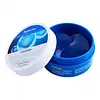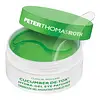What's inside
What's inside
 Key Ingredients
Key Ingredients

 Benefits
Benefits

 Concerns
Concerns

 Ingredients Side-by-side
Ingredients Side-by-side

Water
Skin ConditioningChondrus Crispus Powder
AbrasiveButylene Glycol
HumectantCeratonia Siliqua Gum
EmollientDipropylene Glycol
HumectantXanthan Gum
EmulsifyingAllantoin
Skin ConditioningPhenoxyethanol
PreservativePEG-60 Hydrogenated Castor Oil
EmulsifyingMethylparaben
PreservativeArbutin
AntioxidantDisodium EDTA
Parfum
MaskingPropylparaben
PreservativeTocopheryl Acetate
AntioxidantCI 77007
Cosmetic ColorantRicinus Communis Seed Oil
MaskingCalcium Lactate
AstringentPearl Extract
AntioxidantLaminaria Digitata Extract
Skin ProtectingHizikia Fusiforme Extract
Skin ConditioningCodium Fragile Extract
Skin ConditioningSodium Hyaluronate
HumectantColloidal Platinum
Antimicrobial1,2-Hexanediol
Skin ConditioningMacrocystis Pyrifera Extract
Skin ConditioningSpirulina Platensis Extract
Skin ProtectingSargassum Fulvellum Extract
Skin ConditioningLaminaria Japonica Extract
Skin ProtectingEnteromorpha Compressa Extract
Skin ProtectingHydrolyzed Collagen
EmollientEthylhexylglycerin
Skin ConditioningHydrolyzed Coral
Skin ConditioningWater, Chondrus Crispus Powder, Butylene Glycol, Ceratonia Siliqua Gum, Dipropylene Glycol, Xanthan Gum, Allantoin, Phenoxyethanol, PEG-60 Hydrogenated Castor Oil, Methylparaben, Arbutin, Disodium EDTA, Parfum, Propylparaben, Tocopheryl Acetate, CI 77007, Ricinus Communis Seed Oil, Calcium Lactate, Pearl Extract, Laminaria Digitata Extract, Hizikia Fusiforme Extract, Codium Fragile Extract, Sodium Hyaluronate, Colloidal Platinum, 1,2-Hexanediol, Macrocystis Pyrifera Extract, Spirulina Platensis Extract, Sargassum Fulvellum Extract, Laminaria Japonica Extract, Enteromorpha Compressa Extract, Hydrolyzed Collagen, Ethylhexylglycerin, Hydrolyzed Coral
Water
Skin ConditioningGlycerin
HumectantCarrageenan
Dipropylene Glycol
HumectantCeratonia Siliqua Gum
EmollientCucumis Sativus Fruit Extract
EmollientAloe Barbadensis Leaf Juice Powder
Skin ConditioningCaffeine
Skin ConditioningArnica Montana Flower Extract
MaskingSodium Hyaluronate
HumectantHydrolyzed Collagen
EmollientChamomilla Recutita Flower Extract
MaskingCamellia Sinensis Leaf Extract
AntimicrobialTocopheryl Acetate
AntioxidantNiacinamide
SmoothingAdenosine
Skin ConditioningAllantoin
Skin ConditioningMaltodextrin
AbsorbentEthylhexylglycerin
Skin ConditioningButylene Glycol
HumectantCalcium Lactate
AstringentRicinus Communis Seed Oil
MaskingXanthan Gum
EmulsifyingDextrin
AbsorbentPotassium Chloride
Disodium EDTA
PEG-60 Hydrogenated Castor Oil
EmulsifyingChlorphenesin
AntimicrobialPhenoxyethanol
PreservativeMica
Cosmetic ColorantParfum
MaskingCI 19140
Cosmetic ColorantCI 42090
Cosmetic ColorantWater, Glycerin, Carrageenan, Dipropylene Glycol, Ceratonia Siliqua Gum, Cucumis Sativus Fruit Extract, Aloe Barbadensis Leaf Juice Powder, Caffeine, Arnica Montana Flower Extract, Sodium Hyaluronate, Hydrolyzed Collagen, Chamomilla Recutita Flower Extract, Camellia Sinensis Leaf Extract, Tocopheryl Acetate, Niacinamide, Adenosine, Allantoin, Maltodextrin, Ethylhexylglycerin, Butylene Glycol, Calcium Lactate, Ricinus Communis Seed Oil, Xanthan Gum, Dextrin, Potassium Chloride, Disodium EDTA, PEG-60 Hydrogenated Castor Oil, Chlorphenesin, Phenoxyethanol, Mica, Parfum, CI 19140, CI 42090
Ingredients Explained
These ingredients are found in both products.
Ingredients higher up in an ingredient list are typically present in a larger amount.
Allantoin is a soothing ingredient known for its protective and moisturizingg properties. Because of this, it is often added to products with strong active ingredients.
Studies show higher concentrations of this ingredient can promote wound healing.
Though it can be derived from the comfrey plant, allantoin is produced synthetically for cosmetic products to ensure purity.
Learn more about AllantoinButylene Glycol (or BG) is used within cosmetic products for a few different reasons:
Overall, Butylene Glycol is a safe and well-rounded ingredient that works well with other ingredients.
Though this ingredient works well with most skin types, some people with sensitive skin may experience a reaction such as allergic rashes, closed comedones, or itchiness.
Learn more about Butylene GlycolCalcium Lactate is created by combining lactic acid with calcium carbonate or calcium hydroxide.
Ceratonia Siliqua Gum is extracted from the seeds of the carob tree. You might know this ingredient as Carob Gum or Locust Bean Gum. It is used to stabilize other ingredients and improve the texture of products.
Carob gum is made up of long-chain polysaccharides. This makes it a natural thickener.
Yes! This ingredient comes from the seeds of a tree. The name 'Locust Bean Gum' can be misleading.
Learn more about Ceratonia Siliqua GumDipropylene Glycol is a synthetically created humectant, stabilizer, and solvent.
This ingredient helps:
Dipropylene glycol is technically an alcohol, but it belongs to the glycol family (often considered part of the ‘good’ alcohols). This means it is hydrating and gentle on skin unlike drying solvent alcohols like denatured alcohol.
As a masking agent, Dipropylene Glycol can be used to cover the smell of other ingredients. However, it does not have a scent.
Studies show Dipropylene Glycol is considered safe to use in skincare.
Learn more about Dipropylene GlycolDisodium EDTA plays a role in making products more stable by aiding other preservatives.
It is a chelating agent, meaning it neutralizes metal ions that may be found in a product.
Disodium EDTA is a salt of edetic acid and is found to be safe in cosmetic ingredients.
Learn more about Disodium EDTAEthylhexylglycerin (we can't pronounce this either) is commonly used as a preservative and skin softener. It is derived from glyceryl.
You might see Ethylhexylglycerin often paired with other preservatives such as phenoxyethanol. Ethylhexylglycerin has been found to increase the effectiveness of these other preservatives.
Hydrolyzed collagen has a misleading name because it is actually a mixture of various proteins/peptides. This ingredient has skin hydrating properties.
Collagen is the most abundant type of structural protein found in your body. In your skin, it is responsible for keeping it firm and youthful.
Hydrolyzed Collagen is created by breaking up proteins into smaller peptide bonds. These peptides act as humectants and emollients.
Humectants are great at holding onto water, keeping skin hydrated. Emollients create a thin barrier on the skin to prevent moisture from escaping.
There is ongoing debate about whether hydrolyzed collagen works because it increases skin hydration. Skin hydration is also linked to elasticity and the appearance of wrinkles.
Collagen or peptide ingredients can be used in the morning or night. They will not increase sun sensitivity, but you should always wear sunscreen during the day.
According to a manufacturer, this ingredient is a great hair conditioner as well.
This ingredient can be extracted from different sources, including:
Vegan collagen is derived from yeast, bacteria, or plant sources. Vegan collagen would go by a different INCI name, such as hydrolyzed soy protein.
The results are varied.
A study from 2021 found hydrolyzed collagen increased elasticity and improved wrinkles in 1,125 participants between age 20 and 70. Another study found increased skin thickness in participants between the ages of 45 to 59.
However, It is difficult to prove that oral collagen will end up working on your skin. Many of the studies using hydrolyzed collagen also add several vitamins and nutrients into the test mixture as well.
Further studies are needed at this time.
Learn more about Hydrolyzed CollagenParfum is a catch-all term for an ingredient or more that is used to give a scent to products.
Also called "fragrance", this ingredient can be a blend of hundreds of chemicals or plant oils. This means every product with "fragrance" or "parfum" in the ingredients list is a different mixture.
For instance, Habanolide is a proprietary trade name for a specific aroma chemical. When used as a fragrance ingredient in cosmetics, most aroma chemicals fall under the broad labeling category of “FRAGRANCE” or “PARFUM” according to EU and US regulations.
The term 'parfum' or 'fragrance' is not regulated in many countries. In many cases, it is up to the brand to define this term.
For instance, many brands choose to label themselves as "fragrance-free" because they are not using synthetic fragrances. However, their products may still contain ingredients such as essential oils that are considered a fragrance by INCI standards.
One example is Calendula flower extract. Calendula is an essential oil that still imparts a scent or 'fragrance'.
Depending on the blend, the ingredients in the mixture can cause allergies and sensitivities on the skin. Some ingredients that are known EU allergens include linalool and citronellol.
Parfum can also be used to mask or cover an unpleasant scent.
The bottom line is: not all fragrances/parfum/ingredients are created equally. If you are worried about fragrances, we recommend taking a closer look at an ingredient. And of course, we always recommend speaking with a professional.
Learn more about ParfumPeg-60 Hydrogenated Castor Oil comes from hydrogenated castor oil. It is a solubilizer and emulsifier.
As a solubilizer, it helps dissolve ingredients into a water-based version. It is also an emulsifer. Emulsifier help prevent oils and water from separating. Both these properties help create evenly-spread and uniform products.
Basically, Peg-60 Hydrogenated Castor Oil helps hold ingredients together.
Learn more about PEG-60 Hydrogenated Castor OilPhenoxyethanol is a preservative that has germicide, antimicrobial, and aromatic properties. Studies show that phenoxyethanol can prevent microbial growth. By itself, it has a scent that is similar to that of a rose.
It's often used in formulations along with Caprylyl Glycol to preserve the shelf life of products.
Ricinus Communis Seed Oil is the INCI name for castor oil.
Castor Oil helps moisturize the skin. It is rich in a fatty acid called ricinoleic acid. This fatty acid helps prevent moisture loss on the skin. This helps keep your skin soft and hydrated. Ricinoleic acid also has anti-inflammatory and pain reducing properties.
Besides hydrating the skin, castor oil is also used to hydrate hair. By keeping the hair shaft moisturized, breakage is decreased. More studies are needed to show castor oil's effective on stimulating hair growth.
Castor oil is created by cold-pressing castor seeds and then purifying the oil with heat. It was used in Ancient Egypt as fuel in lamps and to help treat eye irritation.
The term 'fragrance' is not regulated in many countries. In many cases, it is up to the brand to define this term. For instance, many brands choose to label themselves as "fragrance-free" because they are not using synthetic fragrances. However, their products may still contain ingredients such as essential oils that are considered a fragrance.
Learn more about Ricinus Communis Seed OilSodium Hyaluronate is hyaluronic acid's salt form. It is commonly derived from the sodium salt of hyaluronic acid.
Like hyaluronic acid, it is great at holding water and acts as a humectant. This makes it a great skin hydrating ingredient.
Sodium Hyaluronate is naturally occurring in our bodies and is mostly found in eye fluid and joints.
These are some other common types of Hyaluronic Acid:
Learn more about Sodium HyaluronateTocopheryl Acetate is AKA Vitamin E. It is an antioxidant and protects your skin from free radicals. Free radicals damage the skin by breaking down collagen.
One study found using Tocopheryl Acetate with Vitamin C decreased the number of sunburned cells.
Tocopheryl Acetate is commonly found in both skincare and dietary supplements.
Learn more about Tocopheryl AcetateWater. It's the most common cosmetic ingredient of all. You'll usually see it at the top of ingredient lists, meaning that it makes up the largest part of the product.
So why is it so popular? Water most often acts as a solvent - this means that it helps dissolve other ingredients into the formulation.
You'll also recognize water as that liquid we all need to stay alive. If you see this, drink a glass of water. Stay hydrated!
Learn more about WaterXanthan gum is used as a stabilizer and thickener within cosmetic products. It helps give products a sticky, thick feeling - preventing them from being too runny.
On the technical side of things, xanthan gum is a polysaccharide - a combination consisting of multiple sugar molecules bonded together.
Xanthan gum is a pretty common and great ingredient. It is a natural, non-toxic, non-irritating ingredient that is also commonly used in food products.
Learn more about Xanthan Gum